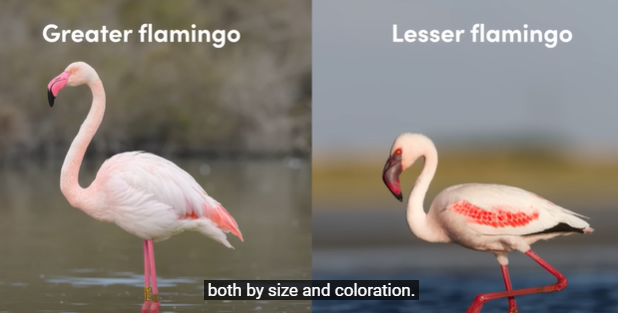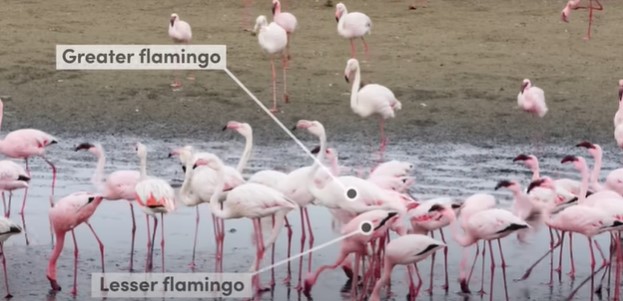Lake Nakuru National Park is famous for hosting two species of flamingos—Lesser Flamingos (Phoenicopterus minor) and Greater Flamingos (Phoenicopterus roseus). These two species are often seen feeding side by side along the shores of Lake Nakuru, creating stunning pink hues across the landscape. While they share many similarities, there are distinct differences between the Lesser and Greater Flamingos in terms of appearance, behavior, diet, and habitat preferences. Understanding these differences can enhance your birdwatching experience at the park.

1. Size and Appearance
One of the most noticeable differences between the Lesser and Greater Flamingos is their size.
- Lesser Flamingo: As the name suggests, Lesser Flamingos are smaller, standing about 80-90 cm (31-35 inches) tall. They have a more delicate and slender build compared to the Greater Flamingo. The plumage of Lesser Flamingos is a deeper pink, almost magenta, which is especially noticeable on their wings and necks. Their bill is dark, with a deep red hue at the base and black on the tip.
- Greater Flamingo: Greater Flamingos are significantly larger, standing about 120-150 cm (47-59 inches) tall. They have a more robust body structure and longer necks. Their plumage is pale pink or white, with some pinkish feathers visible on their wings. The bill of the Greater Flamingo is pink with a distinctive black tip, and it is more elongated than that of the Lesser Flamingo.

In summary, Greater Flamingos are taller, paler, and more robust, while Lesser Flamingos are smaller and have a more vibrant pink coloration.
2. Feeding Behavior and Diet
Both species feed by filtering small organisms from the water, but their diets and feeding methods differ due to the structure of their beaks.
- Lesser Flamingo: Lesser Flamingos feed almost exclusively on Spirulina, a type of blue-green algae that thrives in the alkaline waters of Lake Nakuru. Their specialized beak is adapted to filter tiny algae from the water. As a result, they feed with their heads completely submerged, using a unique pumping mechanism to strain food from the water. This algae-rich diet is what gives them their characteristic deep pink color.
- Greater Flamingo: Greater Flamingos have a more varied diet that includes crustaceans, small fish, plankton, and invertebrates, in addition to algae. Their beaks are larger and less specialized than those of the Lesser Flamingo, allowing them to feed on a wider range of food sources. They typically feed by sweeping their beaks side to side through the shallow water, filtering food from the water with their specialized lamellae (comb-like structures inside their bills).
In essence, Lesser Flamingos are more specialized feeders, primarily eating algae, while Greater Flamingos have a broader diet that includes small aquatic animals.
3. Habitat Preferences
Although both flamingo species are found at Lake Nakuru, they show some differences in habitat preference within the park.
- Lesser Flamingo: Lesser Flamingos prefer more alkaline waters, where their preferred food source—algae—thrives. They are usually seen in large flocks at the shallower parts of the lake, where algae is abundant. These conditions make Lake Nakuru an ideal habitat for them, especially during periods of stable water levels and high salinity.
- Greater Flamingo: Greater Flamingos are more adaptable to different water conditions and can tolerate both alkaline and freshwater environments. At Lake Nakuru, they tend to be found in slightly deeper waters compared to Lesser Flamingos, as their varied diet includes small invertebrates and crustaceans that inhabit deeper areas. They are less reliant on algae and can be seen in smaller groups than the large congregations of Lesser Flamingos.
4. Population and Distribution
The population dynamics of Lesser and Greater Flamingos at Lake Nakuru differ based on environmental conditions and food availability.
- Lesser Flamingo: Lesser Flamingos have historically been present in larger numbers at Lake Nakuru, sometimes in the millions, creating the famous “pink sea” effect on the lake. However, their population can fluctuate significantly depending on the water levels, salinity, and algae production. When conditions are less favorable, such as during periods of high rainfall and diluted lake water, Lesser Flamingos may migrate to other Rift Valley lakes like Lake Bogoria or Lake Natron.
- Greater Flamingo: Greater Flamingos are less numerous than Lesser Flamingos at Lake Nakuru. Their population is more stable since they have a broader diet and are less affected by changes in algae production. However, they are often overshadowed by the large numbers of Lesser Flamingos, even though they can be found throughout the year.
In terms of population size, Lesser Flamingos generally dominate Lake Nakuru in terms of sheer numbers, but their presence is more sensitive to environmental changes, whereas Greater Flamingos are more consistent in their population size.
5. Coloration Differences
The color of the two species also serves as a key distinguishing feature.
- Lesser Flamingo: Lesser Flamingos are typically a deeper pink or magenta color, especially in their feathers and beaks. Their intense color is a direct result of their diet, which is rich in Spirulina, the blue-green algae that contains high levels of beta-carotene.
- Greater Flamingo: Greater Flamingos, on the other hand, have a paler pink or even white appearance, with some pink highlights on their wings and legs. This is due to their more varied diet, which includes fewer carotenoid-rich algae than that of Lesser Flamingos.
Thus, the more vibrant pink hue of the Lesser Flamingo compared to the softer pink of the Greater Flamingo is another clear visual difference.
6. Behavior and Social Structure
Both flamingo species are highly social birds, but their flock sizes and interactions can differ.
- Lesser Flamingo: Lesser Flamingos are known for forming large, densely packed flocks, sometimes numbering in the hundreds of thousands or even millions. Their large groupings provide protection from predators and enhance feeding efficiency. Their synchronized movements while feeding or flying are a spectacle to behold.
- Greater Flamingo: Greater Flamingos tend to form smaller, more scattered groups. While they are also social, they do not gather in such immense flocks as the Lesser Flamingos. Their feeding behavior is more individualistic, as they often forage alone or in smaller groups.
In terms of social behavior, Lesser Flamingos are more likely to be seen in massive congregations, while Greater Flamingos maintain smaller group sizes.
Comparison Table of Lesser vs Greater Flamingo at L. Nakuru National Park
Here’s an expert comparison table that highlights the key differences between Lesser Flamingos and Greater Flamingos at Lake Nakuru National Park:
| Feature | Lesser Flamingo (Phoenicopterus minor) | Greater Flamingo (Phoenicopterus roseus) |
|---|---|---|
| Size | Smaller: 80-90 cm (31-35 inches) | Larger: 120-150 cm (47-59 inches) |
| Plumage Color | Deep pink to magenta, especially on wings and neck | Pale pink to white, with pink highlights on wings and legs |
| Bill Color | Dark red with black tip | Pink with black tip |
| Diet | Primarily feeds on Spirulina algae | More varied diet: crustaceans, small fish, plankton, algae |
| Feeding Behavior | Filters algae from shallow waters with submerged head | Sweeps beak side to side, filtering food from water |
| Habitat Preference | Prefers shallow, highly alkaline waters | Tolerates both alkaline and freshwater environments |
| Flock Size | Forms large, densely packed flocks, often in the hundreds of thousands or millions | Forms smaller, more scattered groups |
| Coloration | More vibrant, deeper pink due to algae-rich diet | Paler pink due to a more varied diet |
| Beak Structure | Specialized for filtering small algae | Less specialized, adapted to a wider range of food |
| Water Depth | Found in shallower waters | Found in slightly deeper waters |
| Population Dynamics | Large numbers, but fluctuates with environmental changes | Smaller population, but more stable throughout the year |
| Migration | Migrates frequently to other Rift Valley lakes when conditions are unfavorable | Less prone to migration, stays relatively consistent year-round |
| Social Behavior | Highly social, forming synchronized feeding groups | Social but more independent, often seen foraging alone or in smaller groups |
| Key Attraction | Forms the iconic “pink sea” on Lake Nakuru during peak conditions | Not as visually dominant, but still a striking sight |
Conclusion
Although Lesser and Greater Flamingos share the same habitat at Lake Nakuru, they are distinct in many ways. Lesser Flamingos are smaller, more vibrantly pink, and specialized algae feeders, while Greater Flamingos are larger, paler, and have a more varied diet. Their habitat preferences, feeding behaviors, and population dynamics also differ, making both species fascinating to observe. Understanding these differences not only enhances your birdwatching experience but also provides a deeper appreciation for the unique ecological balance that supports these iconic birds at Lake Nakuru National Park.
